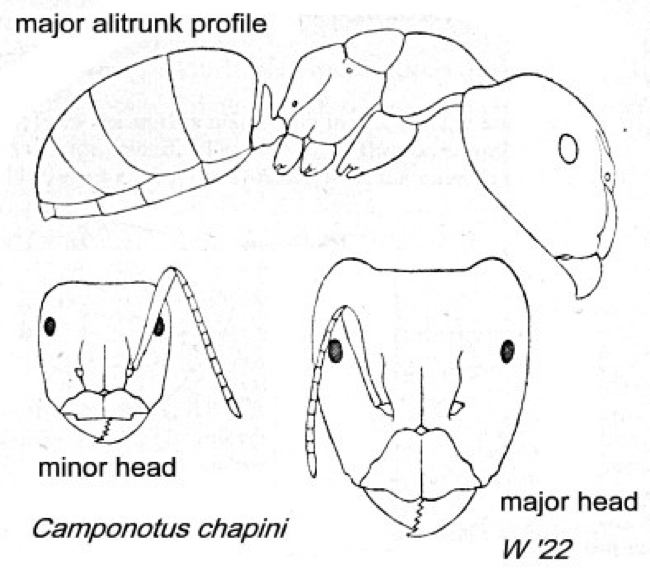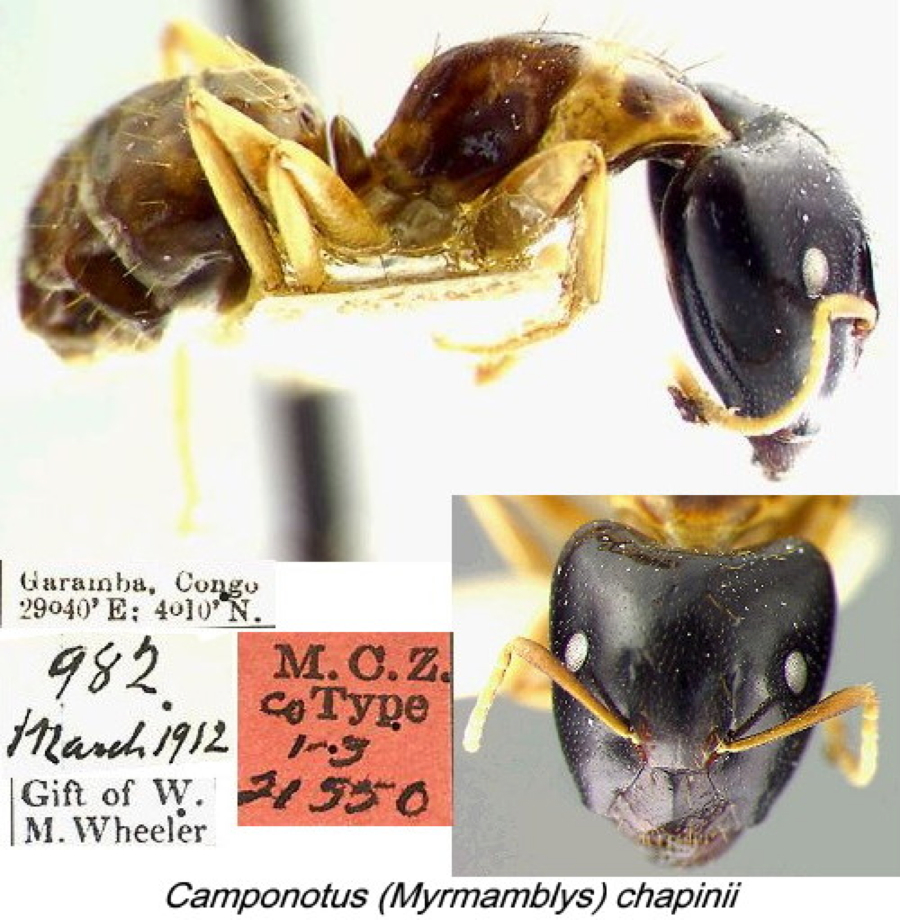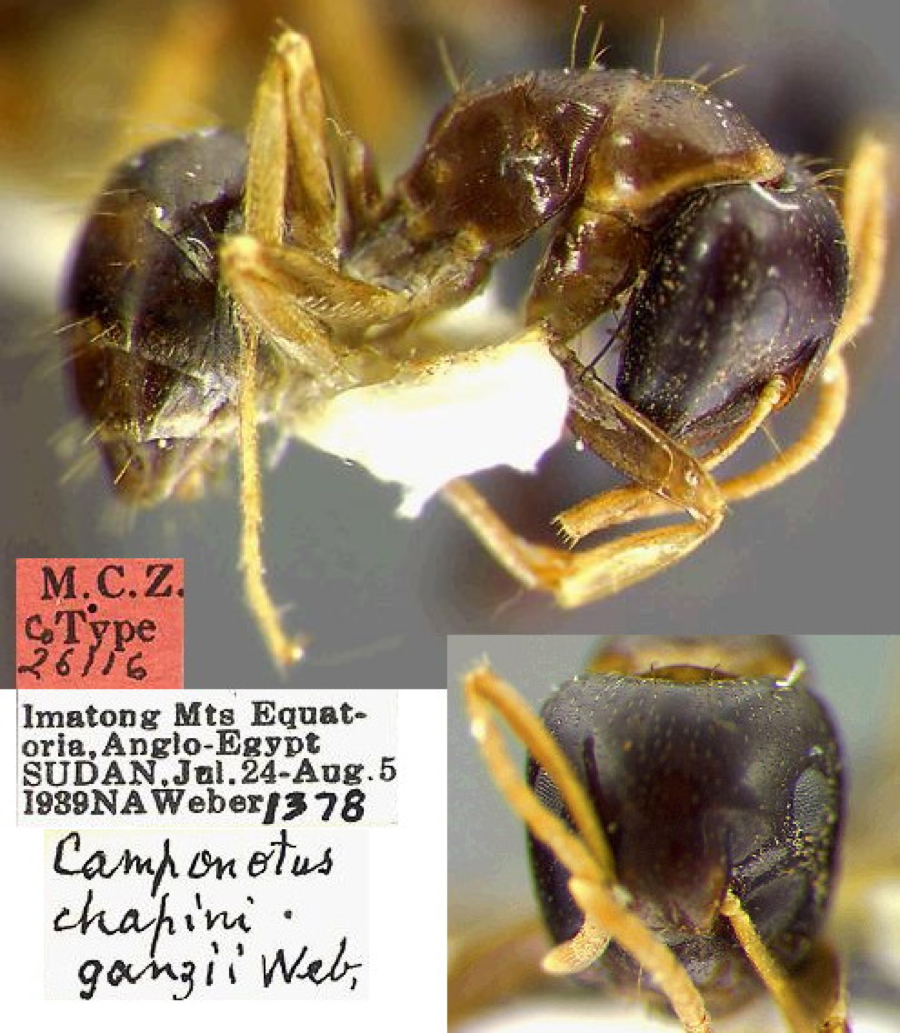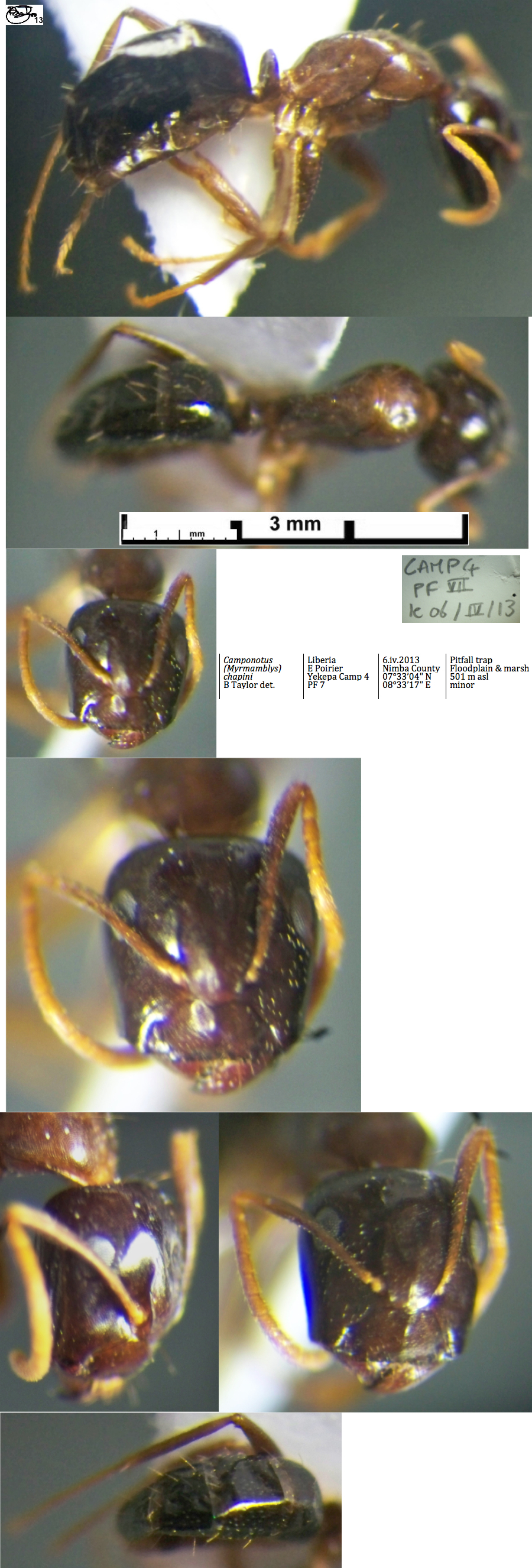Camponotus (Myrmamblys) chapini Wheeler
  Type location Zaïre
(Camponotus (Myrmamblys) chapini
new species, Wheeler, 1922a: 254, illustrated, major & minor
workers) Lukolela, Lang & Chapin - see below Type location Zaïre
(Camponotus (Myrmamblys) chapini
new species, Wheeler, 1922a: 254, illustrated, major & minor
workers) Lukolela, Lang & Chapin - see below
subspecies ganzii (Camponotus
(Myrmamblys) chapini Wheeler ganzii
subsp. nov., Weber, 1943c: 386, major & minor workers) from South
Sudan,
Imatong Mts, 4100', N A Weber - see below
major and worker described (see Bolton, 1995)  . .
|
 Wheeler's
description (1922) was - Wheeler's
description (1922) was -
WORKER MAJOR - length 5.5 to 6.5 mm. Head very large in proportion to
the remainder of the body, longer than broad (without the mandibles,
2.4 X 2.2 mm), broader behind than in front, with deeply excised
posterior, rather convex lateral borders and prominent, rounded
posterior corners. Mandibles stout, convex, coarsely 6-toothed. Clypeus
flattened, strongly carinate, its anterior border notched on each side,
with a short median lobe, angularly emarginate in the middle and
rounded at the corners. Frontal area obsolete; frontal groove distinct;
frontal carinae approximated in front, subparallel and widely separated
behind, nearly as far apart as their distance from the lateral borders
of the head. Eyes small and flat. Antennae short, scapes (1.2 mm)
curved, somewhat flattened basally and thickened at their tips, which
extend only about three times their greatest diameter beyond the eyes.
Thorax small, short, and robust, not longer than the head, very broad
through the pronotum, which is as broad as long, very rapidly narrowed
to the laterally compressed epinotum; the mesonotum and propodeum
together not longer than the pronotum. Promesonotal suture strongly
impressed, metanotum very small and short, but distinct. In profile the
general dorsal outline of the thorax is arcuate, but the mesonotum is
somewhat raised in front at the suture above the pronotum; the
propodeum sloping, rounded, with indistinct, subequal base and
declivity. Petiole small, its scale elliptical from behind, evenly
rounded above, with a slight angular projection in the middle of the
superior border; in profile scarcely thicker below than above, much
compressed anteroposteriorly, about three times as high as thick, with
blunt superior border. Gaster much smaller than the head, the first
segment anteriorly truncated, the dorsal surface convex. Legs rather
stout, tibiae slightly flattened, tarsal claws rather long. Shining
throughout; mandibles coarsely punctate, at their bases shagreened and
subopaque. Clypeus and head sharply shagreened and covered with coarse,
sparse punctures, which are very uniform on the clypeus and cheeks,
somewhat shallower and more scattered on the front and vertex.
Posterior corners of head with a few elongate foveolae. Thorax and
gaster more finely shagreened than the. head, the gaster transversely,
and both with scattered piligerous punctures. Hairs yellow, sparse,
coarse, erect, and rather short. Petiolar border with four setae; gula
with only a few short hairs; cheeks hairless. Scapes naked; tibiae with
numerous, very short subappressed hairs. Pubescence sparse, appressed,
distinct, short on the mandibles, clypeus, and cheeks, longer on the
gaster. Head deep castaneous, almost black; mandibles and anterior
portion of clypeus deep red; antennae, pronotum, coxae, and legs
brownish yellow or testaceous; remainder of thorax, petiole, gaster,
and an inverted V-shaped spot on the dorsal surface of the pronotum,
pale castaneous.
|
 WORKER
MINOR - length 3 to 4.5 mm. Differing from the major in its much
smaller size and the shape of the head, which is as broad as long, a
little broader behind than in front, with straight sides and feebly
convex posterior border. Clypeus strongly carinate as in the major, but
its anterior lobe with straight entire anterior border and subdentate
angles. Mandibles smoother than in the major, much less distinctly
punctate. Antennal scapes extending about one-fifth their length beyond
the posterior corners of the head. Sculpture, pilosity, and color much
as in the major, worker, but the thorax uniformly brown throughout, and
the head paler, though darker than the thorax and gaster. WORKER
MINOR - length 3 to 4.5 mm. Differing from the major in its much
smaller size and the shape of the head, which is as broad as long, a
little broader behind than in front, with straight sides and feebly
convex posterior border. Clypeus strongly carinate as in the major, but
its anterior lobe with straight entire anterior border and subdentate
angles. Mandibles smoother than in the major, much less distinctly
punctate. Antennal scapes extending about one-fifth their length beyond
the posterior corners of the head. Sculpture, pilosity, and color much
as in the major, worker, but the thorax uniformly brown throughout, and
the head paler, though darker than the thorax and gaster.
Described from five major and eleven minor workers from Garamba, Zaïre
(type locality), a major from Medje, and a minor from Faradje (Lang and
Chapin). The specimen from the locality last mentioned is from the
stomach of a frog (Rana occipitalis) and three of the workers
from Garamba are from the stomach of a toad (Bufo regularis).
According to a note accompanying the Garamba specimens, "these ants
nest in small conical termitaria", and, "there are few of these
termitaria without ants, which sometimes run about in the same
galleries as the termites but seem more often to have no dealings with
these insects".
Listed as a savannah species in Ivory Coast by
Lévieux & Louis (1975).
The photomontage is of a cotype of Camponotus chapini.
The original photographs, together with enlarged images, are from the
MCZ, Harvard University, website at - MCZ link.
See also http://www.antweb.org/specimenImages.do?code=casent0911658
|
 Weber's (1943c)
description of ganzii is at Weber's (1943c)
description of ganzii is at  . The photomontage is of a cotype of Camponotus
chapini ganzii Weber (1943c). The original photographs, together
with enlarged images, are from the MCZ, Harvard University, website at
- MCZ link. . The photomontage is of a cotype of Camponotus
chapini ganzii Weber (1943c). The original photographs, together
with enlarged images, are from the MCZ, Harvard University, website at
- MCZ link.
|
Oxford University Museum
specimens
Camponotus (Myrmamblys) chapini
B Taylor det.
|
Liberia
E Poirier
Yekepa Camp 4
PF 7
|
6.iv.2013
Nimba County
07°33’04" N
08°33’17" E
|
Pitfall trap
Floodplain & marsh
501 m asl
minor
|
1
|
 |
Camponotus (Myrmamblys) chapini
B Taylor det.
|
Liberia
E Poirier
Yekepa Camp 4
PF 9
|
6.iv.2013
Nimba County
07°33’04" N
08°33’17" E
|
Pitfall trap
Floodplain & marsh
501 m asl
minor
|
1
|
 |
|
 The
photomontage is of a minor from Liberia, collector E Poirier
(Yekepa camp 4 PF7). The
photomontage is of a minor from Liberia, collector E Poirier
(Yekepa camp 4 PF7).
|
|